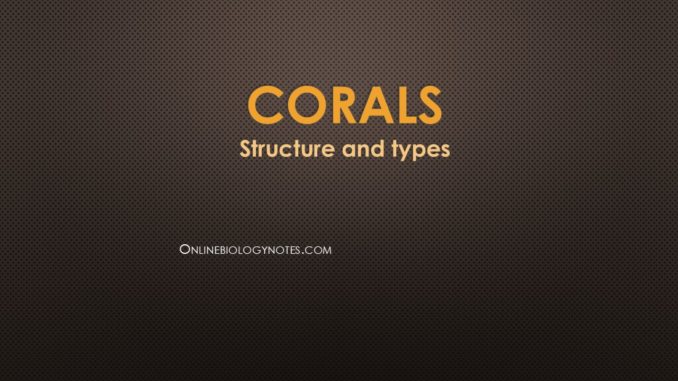
What is coral?
- Corals (coral animals) are marine, mostly colonial, polyploid coelenterates, looking like miniature sea anemones and living in a secreted skeleton of their own.
- Their calcareous or horny skeleton is also commonly known as coral.
- Some corals grow into massive, solid structures, others form large, branched colonies.
- Most of the corals belong to the class Anthozoa and a few to the class Hydrozoa of phylum coelenterata.
Coral polyp:
Structure of coral polyps:
- A typical coral polyp from is a small organism about 10mm long and 1 to 3 mm in diameter from a colony.
- Solitary coral polyps are much larger reaching up to 25cm in a diameter.
- A basal disc is absent because the basal region of polyp is surrounded by a calcareous exoskeleton.
- Oral disc bears numerous tentacles, in several rows around an elongated, oval, or circular mouth.
- Pharynx or stomodaeum is short and without siphonoglyphs.
- Mesenteries are restricted to the upper part of coelenteron and mesenterial filaments contain only one glandular lobe bearing nematocysts.
- Body wall is without cinclides and nematocyst bearing structures (acontia).
- Muscles are poorly developed while little is known about nervous system.
- Living polyps are found only on surface layers of coral masses.
- They feed at night both by raptorial and suspension feeding.
- When not feeding, they withdraw into cup-like cavities of skeleton.
Structure of coral skeleton:
- Skeleton of a solitary coral is known as corallite.
- It is a calcareous exoskeleton secreted by epidermis.
- In a colonial coral, corallites of individual poyps fuse together to form a skeletal mass, called corallum.
- Each corallite is like a stony cup with a basal part or basal plate, and a cup wall or theca, enclosing the aboral portion of polyp.
- Cavity of cup contains a number of vertical radiating ridges called sclerosepta, proceeding from theca towards the center of cup.
- Inner ends of sclerosepta are fused to form an irregular central skeletal mass or columella.
Formation of coral skeleton:
- In coral polyps, sexual reproduction takes place by fusion of gametes.
- Zygote develops into a free-swimming ciliated planula larva which settles down and metamorphoses into a young coral polyp.
- There is no medusa stage.
- By asexual budding, single polyp becomes the parent of all other members of the colony.
- The coral polyp begins to secrete a skeletal rudiment or prototheca.
- It is secreted by ectoderm, first as a basal plate.
- Following it, radial folds develop which secrete sclerosepta.
- At the same time, a rim is built up as a thecal wall around the polyp, lying at the top.
- Meanwhile further skeletal material is added into the gaps between sclerosepta of skeleton which usually alternates with mesenteries of the polyp.
- Coral colony grows in size continuously by budding of new polyps, particularly along the margins and on surface layers of coral masses.
- Variety in form of compound corals results due to various patterns of budding.
Types of corals
1. Hydrozoan corals:
- Order Hydrocorallina includes few genera, like Millepora, Stylaster and Distichopora, which are colonial and secrete massive branched calcareous exoskeletons.
- These are found in coral reefs with other corals.
- Skeleton is secreted by a modified epidermis, called calicoblastic layer.
- Living within the skeleton occur two types of polyps, large feeding gastrozooids and defensive dactylozooids.
2. Octocorallian corals:
- Order Alycyonacea includes marine, colonial, and soft corals.
- A well-known genus is Alcyonium, popular as ‘dead man’s fingers’ because of its resemblance to a human hand.
- It has an endoskeleton of separate calcareous spicules embedded in a massive mesoglea or coenenchyme.
- Order Stolonifera includes the organ pipe coral, Tubipora musica, widely distributed on coral reefs in warm waters.
- Skeleton is made of mesogloeal calcareous spicules forming parallel and vertical tubes, each occupied by one polyp, and connected together by lateral platforms.
- Skeleton is dull red in color due to presence of iron salts.
- Order Coenothecalia includes a single genus Heliopora, commonly known as blue coral.
- Its massive calcareous, skeleton or Corallium is secreted by polyps living in large erect, cylindrical solenial tubes on the surface of skeleton.
- Order Gorgonacea includes plant-like colonies of sea fans or horny corals.
- In Gorgonea, colony branches in one plane only.
- Its axial colony is made by horny proteinaceous material intermixed with calcareous spicules arranged around the polyps.
- In precious red coral, Corallium nobile, the branching colony has canaliferous coenenchyme of cocnosarc containing dimorphic polyps.
- Axial skeleton consists of spicules embedded in CaCO3 forming precious hard red coral which is used in jewellery.
3. Hexacorallian corals:
- Order Madrepora includes stony corals or true corals, which are the principal builders of coral reefs.
- While some of them are solitary, most are colonial, assuming a great variety of forms.
4. Solitary corals:
- Fungia, Flabellum, Caryophylla, etc., are the solitary corals or cup corals.
- The corallite is disc-like, cup-like or mushroom-shaped in form and measure 5mm to 25cm across.
- It is often used without a theca.
5. Colonial corals:
- Most of stony corals are colonial with plate-like, cup-like, spherical, or vase-shaped skeleton (coralium).
- Polyps live at the surface of the calcareous skeleton.
- Typical examples of colonial madreporarian corals are Acropora, Oculina, Favia, Madrepora, Meandrina, etc.
- Some of the colonies are branched.
- In stag-horn coral, Acropora, there is always a primary polyp at the top of colony with lateral branches on either side.
- In some corals, like Oculina, polyps remain widely separated, each occupying a separate theca.
- In others, like Favia and Astraea, thecae are so close together as to have common walls.
- In the brain-coral, Meandrina, polyps as well as thecae become confluent, occupying valleys separated by ridges, on the surface of corallum.
